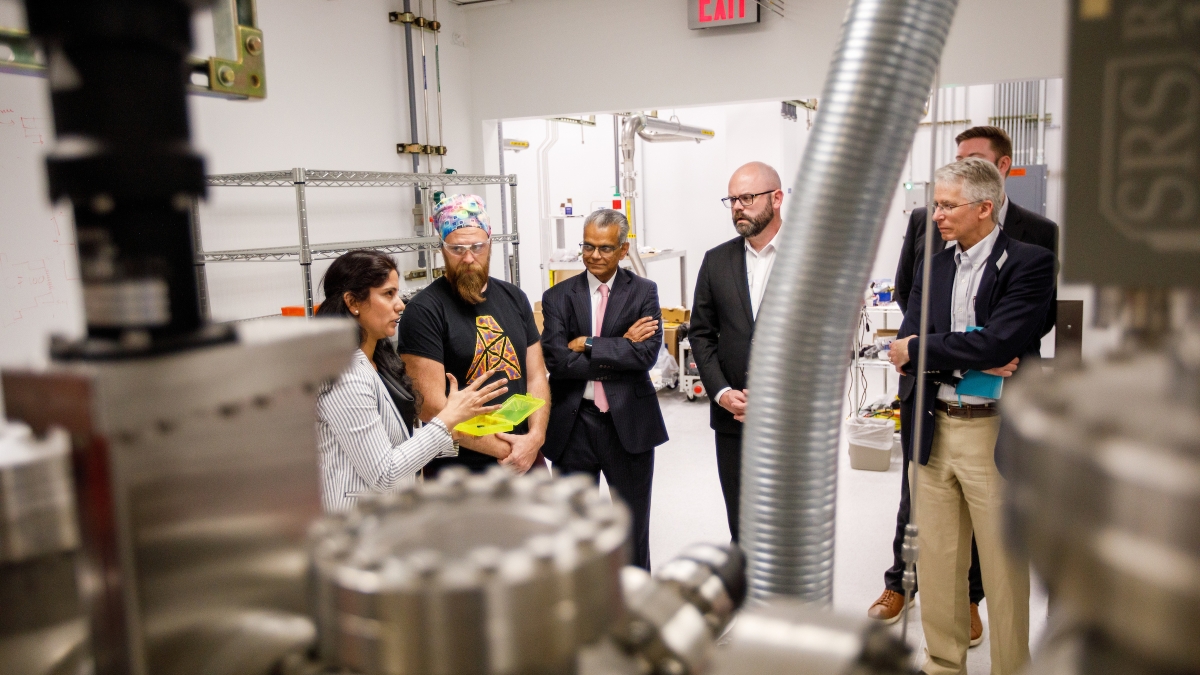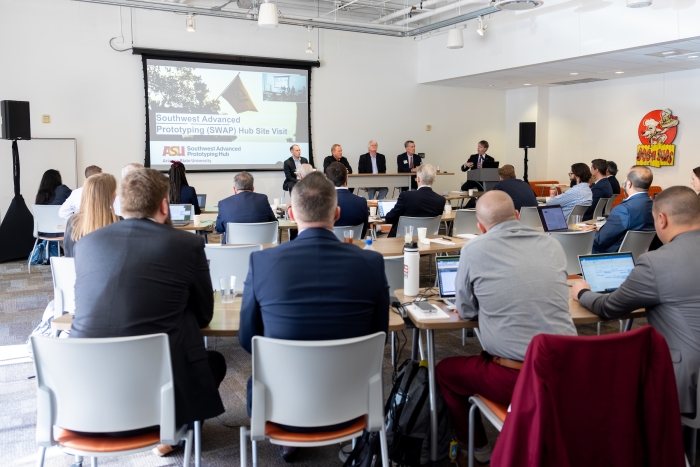The hub, designed to jump-start microelectronics projects funded by the 2022 CHIPS and Science Act, is a collaboration that has grown to more than 130 leading corporate, startup, academic and national lab partners from the semiconductor and defense sectors in Arizona, New Mexico, Colorado and beyond.
The goal is to speed the time it takes to transform lab ideas into practical solutions for the Department of Defense.
In September, the U.S. Department of Defense announced that the SWAP Hub would receive nearly $40 million in funding this year as one of eight “Microelectronics Commons” regional innovation hubs. The SWAP Hub is part of the Microelectronics Commons, a $1.63 billion Department of Defense network of eight regional hubs funded by the 2022 CHIPS and Science Act.
Their trip to ASU was part of a national tour to visit each of the regional hubs and encourage engagement in project proposals, which are due at the end of February.
Devanand Shenoy, who is leading the Department of Defense’s research and engineering efforts in microelectronics, and several other DoD officials met with members of the hub at SkySong, The ASU Scottsdale Innovation Center. The visit was part of a three-week tour of all eight hubs by the DoD team.
“The CHIPS Act has given us a unique opportunity to really refocus a whole-of-nation effort on solving problems related to semiconductor manufacturing. We want to onshore more manufacturing and ‘friendshore’ more manufacturing to make sure that we’ve stabilized the supply chain for semiconductors,” said Liesl Folks, vice president for semiconductor strategy at the University of Arizona, a SWAP Hub partner.
The huge Taiwan Semiconductor Manufacturing Co. facility being built in north Phoenix represents a major public and private investment in relocating some of that manufacturing back to the U.S.
But the “lab-to-fab” gap must be bridged and innovations must be scaled up to support national security.
“One of the challenges that the United States has is we have the world’s biggest, largest, best innovation engine. And we have this gap of getting that innovation to manufacturing and then to production, hence the lab-to-fab gap,” said Ken Potts, senior director of government programs at Synopsys, a SWAP Hub partner.
Shenoy and his team heard about several SWAP Hub successes so far, including increasing the number of partners from about 60 last year to more than 130 now, with about 20 more partners pending. About 50 of the partners are small businesses.
“One of the core challenges in ‘lab-to-fab’ is that small businesses have no means to prototype. The hub will enable that,” said Krishnendu Chakrabarty, chief technology officer of the hub and Fulton Professor of Microelectronics in the School of Electrical, Computer and Energy Engineering.
Tim Olson, CEO of Deca Technologies, a SWAP Hub partner, said that the SWAP Hub is a game changer compared to when he founded his company decades ago.
“One problem we had is we had a great idea but we had to find $100 million to prove the idea and if we had had a SWAP Hub, we could have proved it for free, or a lot less,” he said during a panel discussion at the daylong event.
“It lowers the barrier to entry. I haven’t seen anything like this before.”
The hub provides access to its “clean room” technology and state-of-the-art tools to its partners as well as to ASU students.
Last year, the SWAP Hub put out a call for project ideas and is putting forward more than a dozen that were determined to be a good fit to DoD for potential funding.
“We got 75 concept papers and they were all very strong,” Chakrabarty said. “We were able to attract submissions from almost every hub member.”
The defense department group also heard about the hub’s capabilities in several technical areas, including artificial intelligence, 5G/6G technologies, electronic design automation and commercial leap ahead. Those capabilities are not only because of the facilities, but also the expertise of ASU faculty and partners.
Another critical area that the hub excels in is the ability to provide testing in extreme environments, such as high temperatures and radiation, thanks to a close partnership with Sandia National Labs in New Mexico, according to Kevin Reinhart, director of the Research Project Management Office in the Office of Knowledge Enterprise Development at ASU.
“At the hub, versus at a true foundry, we’re able to take more risks. We won’t upset a foundry process with hundreds of millions of product in its pipeline,” he said.
One of the most important goals of the SWAP Hub — and an issue raised throughout the daylong workshop — is workforce development.
Sally Morton, executive vice president of ASU’s Knowledge Enterprise, said that 1 million skilled semiconductor workers will be needed by 2030.
“The microelectronics talent shortage is especially acute in the defense community,” she said.
The hub will help to train ASU and partner university students by providing access to the tools and facilities of the MacroTechnology Works, and internships with Sandia National Labs are putting students on the path toward careers.
Beyond that, ASU is involved in creating content to reskill and upskill people who are already in the workforce, according to Binil Starly, professor and director of the School of Manufacturing Systems and Networks at ASU.
“Because of the presence of TSMC and Raytheon, there is a lot of need in the technician space,” he said.
“It’s about welding, it’s about plumbing, it’s about instrumentation — everything that’s needed to make the fab run.”
So the university is developing a series of microcredentials — four courses of 10 hours each — that can be stacked into meaningful certificates with the goal of keeping the content as accessible and cost effective as possible.
A panel discussion of industry leaders highlighted the workforce issue.
Rick McCormick, senior manager for advanced semiconductor technology strategy at Sandia National Laboratories, a SWAP Hub partner, called the difficulty in hiring workers an existential threat that requires thinking big.
“… We’re interested in being in a tightly engaged workforce development,” he said. “One of the things I’ve appreciated in working with ASU is that they’re thinking about workforce development at scale, and I think that’s what’s necessary.”















[…] inBusiness PHX […]